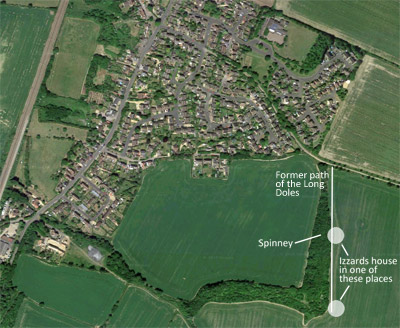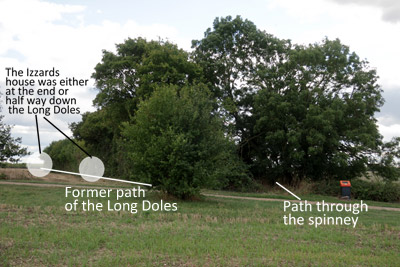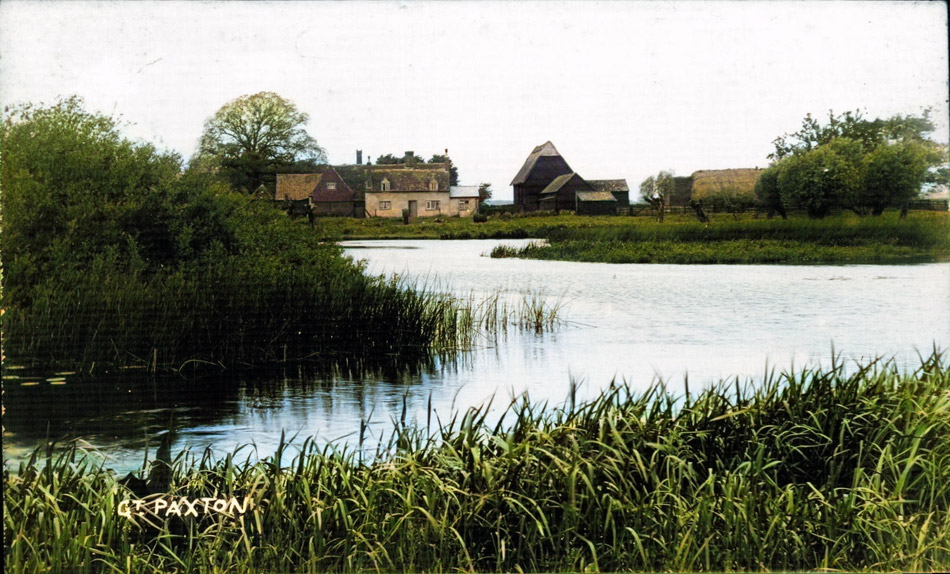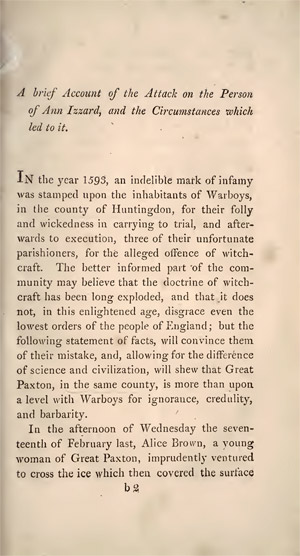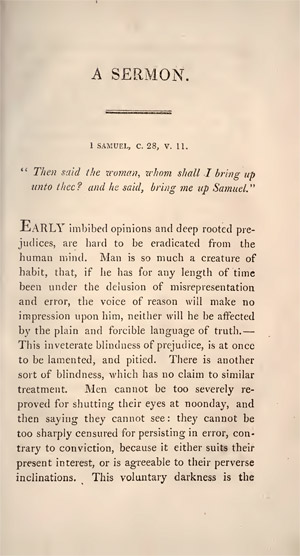 Ann
Izzard (1745-1838)
Ann
Izzard (1745-1838)
The Great Paxton Witch
The Short Version
Ann Izzard of Great Paxton was accused of being a witch in 1808.
She was regarded as an outsider and was seen as “different” in a number of ways.
The early 1800's were a difficult time for Great Paxton, there was much hardship, misfortune and poverty.
Ann was blamed for many of the ills that befell the villagers.
She was attacked as a witch by villagers (about half the adult population at the time) who were trying to break the curses they believed she had placed on them.
In earlier times the law would have supported the villagers, but led by the vicar Rev. Nicholson, nine of Ann’s tormentors were prosecuted for their assault.
They were tried twice at Huntingdon where the case was considered too significant to be dealt with by a provincial court.
They were then tried at Westminster where their crimes though relatively minor set an important precedent, eight were imprisoned for a month with two months for the ring-leader.
Ann left Great Paxton after her attack and moved to Little Paxton where she was again assaulted though less seriously.
She moved to St. Neots which was better though she was still teased by children and lived in three different places.
She died in 1838 aged 93.
The Ann Izzard story is an age old one of a woman persecuted and blamed by people who wanted a scapegoat. It marked an important change in official response from one supportive of the existence and persecution of witches to one that denied the existence of witches and prosecuted those who attacked those they claimed were witches.
A result of the English enlightenment at the end of the "European witch craze".
Ann Izzard wasn't really a witch and the accusations were false.
The Longer Version
The Izzards in Great Paxton
There have been many specific published "facts" about Ann Izzard that are contradictory, especially about her age. Her age at death (93) allows us to work backwards and shows that she was 35 when married and 38 when she had her first child, the last was born when she was 50, these late ages for the time contributed to her being seen as somewhat more "other".
Born Ann Rowe, her possible birth date and place is discussed in the appendix at the bottom of this page.
Ann worked as a live-in servant in 1778 for John Jackson, the farmer at College Farm in Great Paxton, she married Wright Izzard (full name Henry Wright Izzard, known as Wright perhaps to avoid confusion with his father, also Henry) a hand on the same farm on the 21st of Nov 1780.
They moved to the village of Great Staughton about eight miles away shortly afterwards and had a son, Henry in 1783. The records show the burial of a Jane Izzard in that village on the 23rd of September 1782, possibly a younger daughter who died in infancy, other than Ann and Wright's family there are no other records of anyone called Izzard between 1750 and 1800 in Great Staughton.
By this time Ann and Wright were without work and applied for “parish relief”, the benefits system at the time which was paid directly by the local parish. Claimants were often moved on to another parish whenever possible by officials if they could establish that responsibility for them lay elsewhere, so they came back to Great Paxton where Wright had been born and where they had been married.
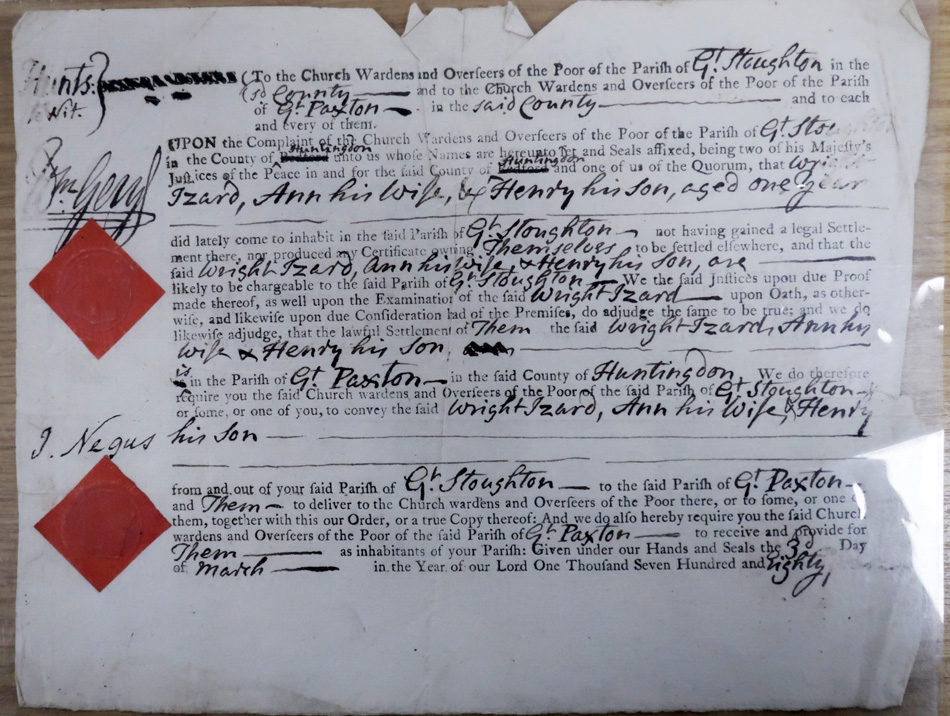 An
order from Great Staughton for Wright Izzard, his wife Ann and
son Henry, to return to Great Paxton, 3rd March 1784.
An
order from Great Staughton for Wright Izzard, his wife Ann and
son Henry, to return to Great Paxton, 3rd March 1784.
Back in Great Paxton they were housed in a small wattle and daub thatched cottage some way from the centre of the village along Long Doles, where the spinney now is, possibly about half way down or maybe at the end where it opens out, one of the most isolated cottages in the parish.
Ann was an outsider within the village, somewhat different and unusual in appearance. One old and respected resident of St. Neots described Ann in later years as rather peculiar looking but really very inoffensive.
Wright Izzard continued to have problems supporting his children and applied for poor relief from the village again for his family in 1804, the Izzards would have been seen by some as a burden on the village.
These payments ended in 1808 when a son, Miles aged 15 or 16 found work with a farmer leading to the family becoming even poorer, there are stories from this time of Ann begging for food. Ann and Wright were living with four surviving children.
Wright Izzard was known as a wizard and Ann was a herbalist in an age when most could not afford medical care she was said to be “skilled in herbs and dimples”*, probably a means by which she could help to boost the family’s meagre income.
In the years 1808-09 with Ann in her 60's life took an altogether different turn for the couple. Ann was accused of witchcraft by a number of villagers.
Great Paxton at the time:
1808 was a bad time in Great Paxton. A publication that year called “The Beauties of England and Wales” describes it as a “small mean village” made of scattered mud-walled and thatched cottages. There were 36 dwellings in 1801 with a population of 217 people, about half the size it had been at the time of the Domesday Book in 1086 and probably at a historical low.
In 1804 the King’s charity (named for a Mr. King and not the monarch) gave a shilling to every poor person in the village, 32 distributions were made to 114 individuals including the Izzards and the families of many of those who would persecute Ann.
This was the time of the Napoleonic wars in Europe and taxes were being levied to pay for them. There was a high death rate, a lack of permanent employment and housing was poor.
Very few villagers had livestock to take advantage of the grazing commons, though there is a record that the Lord of the Manor was able to put out over 400 sheep in 1811.
The enclosures, a series of acts of parliament were under discussion for Huntingdonshire and were authorized shortly after the events described here. Enclosures denied ordinary people long standing historical free access to common land and resources such as grazing for animals and gleaned grain to make bread, so making life more difficult and expensive causing real hardship for many.
Events in Great Paxton
1799 - A 70 year old labourer named Tom Russell, (the husband of Alice Russell who will later help Ann Izzard) had a fit and died at the bottom of Paxton hill.
1801 - James Anvill accidentally drowned.
1803 - James Staughton, the six-year-old son of James and Kesiah Staughton "accidentally drowned in a pond in the [High] Street".
1808, Feb 17th. late afternoon – A young
Great Paxton woman called Alice Brown (age 18) tried to walk
across the frozen river to Little Paxton which cracked and she
fell through. She scrambled out on the opposite bank where her
friend Fanny Amey (age 17) helped her out and took her to her
father’s house. On arrival Alice had an epileptic fit, almost
immediately Fanny (who had a history of epilepsy) also had a
fit, other versions say that it was Alice who had the history
of fits.
Top - The site of the Ferry across the river from Great Paxton to Little Paxton where Alice Brown and Fanny Amey tried to cross the frozen river and fell through on February the 17th 1808. Picture about 1934 (colourized) showing islands similar to how they would have been in 1808.
Left - 2020, the islands in the river have now been dredged out meaning the river is far less likely to freeze. Wray House Farm on the Little Paxton side has now been mostly demolished.
Alice’s fits continued regularly and were blamed on witchcraft.
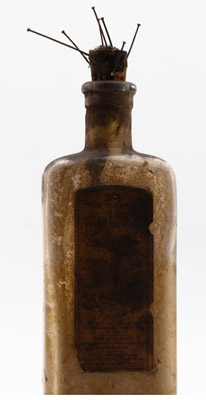 Alice’s
father, Tom Brown, knew of a man in Bedford with similar symptoms,
who had made a Witch Bottle, a small bottle filled with his
urine, sealed with a cork pierced with pins and then put in
an oven. He claimed that the image of an old woman of the parish
had appeared before him, she then died within a few days and
he recovered. Alice’s father tried the same to find who was
bewitching his daughter. It didn’t work, but the idea of witchcraft
had taken root.
Alice’s
father, Tom Brown, knew of a man in Bedford with similar symptoms,
who had made a Witch Bottle, a small bottle filled with his
urine, sealed with a cork pierced with pins and then put in
an oven. He claimed that the image of an old woman of the parish
had appeared before him, she then died within a few days and
he recovered. Alice’s father tried the same to find who was
bewitching his daughter. It didn’t work, but the idea of witchcraft
had taken root.1808, Feb 20th, three days after Alice Brown had fallen through the ice – Robert Emery aged 14 years and 3 months “In a fit of lunacy” hanged himself owing it was thought to the loss of his sight. He had been blind for something more than two months, this was a heavy affliction that preyed upon his mind. He told his father he had “more upon it than he could bare".
1808, April 6th - The rector of Great Paxton, Reverend Nicholson was told by the mother of Alice Brown she thought witchcraft was involved in her daughter's and Fanny Amey’s fits, he visited the two young women (and was told of a third, Mary Fox who had also had fits) and tried to convince them to dismiss their ideas about witchcraft, he was unsuccessful.
1808, April 12th - As Reverend Nicholson
was on his way to church the next Sunday he was approached by
an agitated Ann Izzard, she had heard she was accused of being
the witch who was causing illness and misfortune within the
village. She had been threatened, her children accused and frightened,
she had fainted with fear at hearing the accusations, she told
him “I am not a witch, and am willing to prove it by being weighed
against the Church Bible”.
Rev Nicholson tried in church
to persuade the villagers they were wrong and that witches were
not real but to no avail.
1808, May 5th – This was the day of a decisive
event as far as the villagers were concerned. It was market
day and Ann went to St. Neots to meet her son, they returned
to Great Paxton with a neighbour following a cart. The neighbour
asked to put her basket on the cart, Ann kept advising against
it as one of the horses was young and unmanageable, the neighbour
took no notice and immediately she put her basket on the cart
the horse broke away and the cart was overturned. Within an
hour, the story was all round the village that Ann “Overturned
a loaded cart with as much ease as if it had been a spinning
wheel” supposedly out of spite against the neighbour to spill
her groceries.
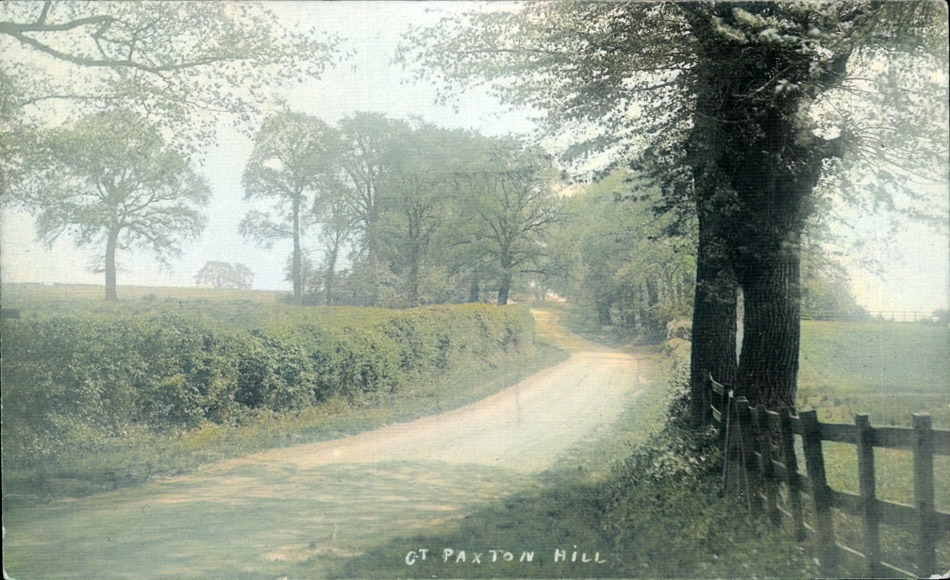 Paxton
Hill - 1915 - colourized
Paxton
Hill - 1915 - colourized
1808, May 8th – After dark and 3 days following the upset cart, a group of about 50 (estimated as half the adults in the village) assembled and went to the Izzard’s cottage at about 10pm. They broke down the door, dragged Ann out of bed and threw her naked into the yard. Wright was restrained while Ann’s arms were gashed with pins to draw blood (to break her spells) her head was dashed against the stones of the path and the door bar used to strike her face, stomach and breast. Leaving her badly beaten, the mob then left.
Ann dressed herself and went to the village constable who didn’t do anything saying he hadn’t been sworn in yet. She sought help from Alice Russell** a poor widow, who unlocked her door, bandaged Ann’s wounds and gave her a bed for the night. Alice was harassed for her kindness, and disturbed by the belief expressed the next morning by the villagers that someone who offers protection to a witch is as bad as the witch herself, she neither eats nor sleeps again, she is taken ill (possibly a seizure) on the 15th of May and dies on the 20th of May.
1808, May 9th - The villagers repeated the
assaults the following night in almost exactly the same way,
Ann remained remarkably resilient, it was only when she heard
she was to be ducked as a witch that she took refuge with the
reverend Nicolson though he was condemned for it by “11 out
of 12 of the villagers”
1808, July - Nicolson’s continued church sermons against the existence of witchcraft and in support of all people along with Ann leaving the village calmed things down.
Nine of those who took part in the assaults were arrested
and tried twice at Huntingdon, in August 1808 and July 1809,
and then in Westminster in November 1809. Eight were sentenced
to a month in prison with the ringleader serving two months.
They were all required to find security for good behaviour for
another two years. None of them felt any remorse for what they
had done as they were convinced Ann was a witch and thought
that was how you dealt with witches.
Following these incidents Ann and her family moved to Little Paxton where she is recorded as making a complaint to the local J.P. of further assaults on the 16th of October 1809. Two women, Judith Day, aged 57 and her daughter Elizabeth Day aged 34 were accused having "...cruelly assaulted Ann Izzard in this county", they were imprisoned for a month each in January 1810.
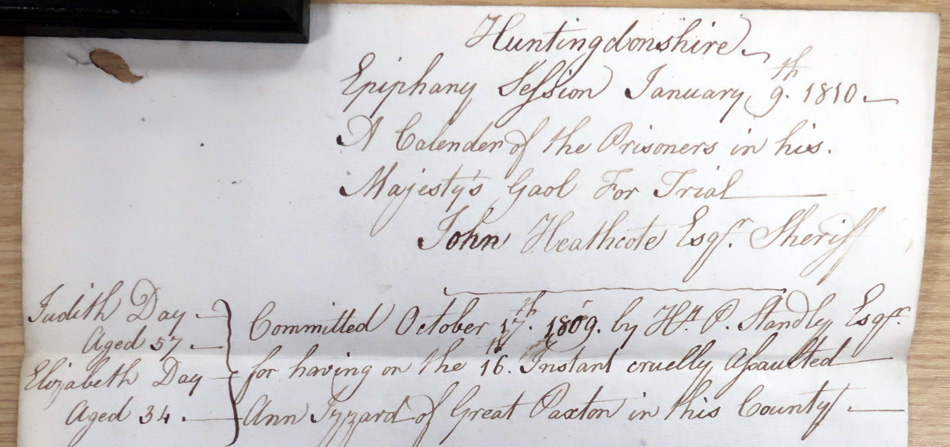 Notice
of the trial of Judith and Elizabeth Day.
Notice
of the trial of Judith and Elizabeth Day.
Ann ended her days in St. Neots, occupying houses in three different parts of town, even then she did not escape persecution being teased by children who lived nearby. Her husband Wright drowned in 1833 which created its own rumours, Ann died 5 years later in 1838, her age is given as 93 on her death certificate, she was buried in St. Mary’s churchyard St. Neots in an unmarked grave.
After Ann's Death
Stories of Ann persisted and were added to as time went by.
100 years or more after her death, legend still said Ann Izzard could be seen at midnight crossing the sky above Potton Corner, Eynesbury on her broomstick. Misbehaving children would be warned that "Nanny Izzard" (as she had become known by then) would swoop on her broomstick and take them away.
Stories of her supposed witchy doings were also told in Abbotsley and Yelling.
In the 1930’s the Great Paxton Women’s Institute collected stories of Ann Izzard from the residents of the village. They found a whole range of tales that were not mentioned in the 1808-09 sources. The earlier sources were the elites written view of the proceedings, the 1930’s were those of non-elites passed by word of mouth for over 120 years.
- She was said to beg bread and giblets of fowl from the
vicarage on Sunday mornings to feed her familiars, knowing
instinctively when fowl was being prepared, if she didn’t
get anything she would curse the cook with “May your goose
never cook” which led to a cold oven.
- Ann was of the habit of obtaining her butter for free,
if refused she put her hand in the churn which would not
turn, farmer Bidwell stopped this by putting a red hot poker
in the churn.
- She could be seen flying over the village on a broomstick.
- Mr. Papworth, the village shop keeper and landlord of the Bell was said to have refused her credit, in response Ann bewitched his wife. While entertaining a friend to tea Mrs. Papworth had some sort of fit and danced on the tea table. The friend seized Ann and held her down while the two women scratched her with a pin to draw blood and break the spell.
These later oral stories are similar or identical to those about witches from all across Europe. Rather than being stories about Ann Izzard, they are generic witch-tales attributed to whoever was locally accused of being a witch.
Other Notes:
Those sent to prison for attacking Ann:
-
Mary Amey - mother of Fanny Amey.
-
Edward Briers.
-
Thomas Braybrook.
-
Alice Brown, Fanny Amey and Mary Fox the three whose fits had precipitated the idea that Ann was a witch and had cursed various inhabitants of the village.
-
Joseph Harper.
-
Mary Hook - had lost 4 of her 7 children while very young, most under 18 months old, another would die in July 1808 of unknown causes.
-
James Staughton - lost his 6 year old son James in 1803 after he accidentally drowned in a pond in the [High] street. As ringleader he was imprisoned for two months.
* Dimple - the footprint left when a cloven footed animal such as cow, pig or sheep walks on soft ground, if left undisturbed any herbs that grew in such dimples were thought to have more potent healing properties.
**Alice Russell lived in a farm cottage where the garage of 7A Church Lane now stands.
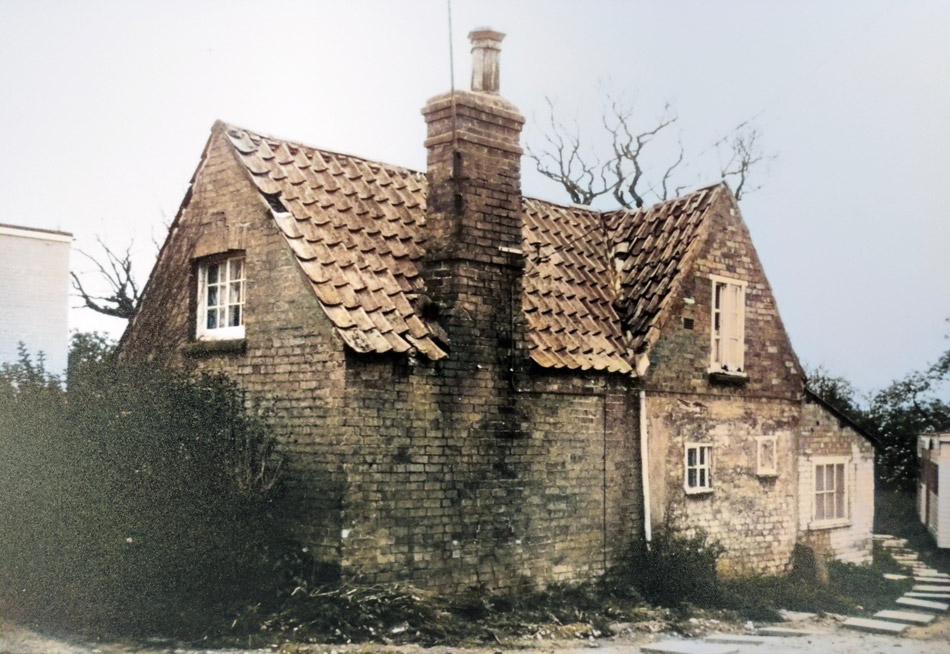 Alice Russell's cottage in Church
Lane, demolished in the 1970's - colourized
Alice Russell's cottage in Church
Lane, demolished in the 1970's - colourized
It would most likely have been thatched in 1808
Scratching a witch was a popular though illegal test to reveal a witch and persisted in England from the 13th to 19th centuries. The bewitched victim would draw the blood of the suspected witch with nails, a pin, a needle or other means, this would give temporary relief of the symptoms so providing proof of the witch. Each person who thought they were bewitched had to do this individually, hence why Ann Izzard suffered so many separate attacks.
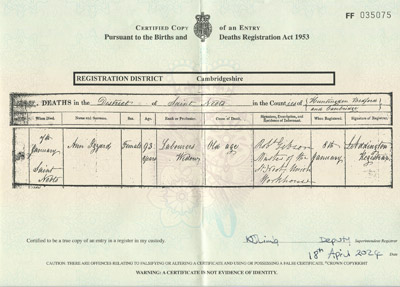
Appendix:
There have been many conflicting and contradictory "facts" about Ann Izzard reported, so I approached her from a genealogical perspective compiling a view of her family with the aid of family history websites.
Prior to 1837 in England only churches recorded baptisms, marriages and deaths, births were not recorded though baptism would typically take place in the first year of life, usually very early. From 1837 these events were recorded by law though it was a law that was not very strictly applied for another 50 years or so.
Ann Izzard birth and death: Ann Izzard died in 1838, probably in St. Neots workhouse infirmary, a place where this law would have been more closely adhered to, her given age as 93 allows us to estimate her birth year and more importantly to rule out some of the possible places previously given for her birth. Her death was reported by a Robert Gibson, the "Master of the St. Neots Union Workhouse", this doesn't necessarily mean that she was a workhouse inmate at the time as in pre-NHS days infirmaries that were always part of workhouses were often the only infirmary or hospital in the area available to much of the population.
Her birth date would have been around 1745, recorded ages and dates are often not a perfect match commonly varying by a year or two (sometimes more) from one record to another. There is an Ann Rowe whose baptism was recorded at All Saints Church, Cambridge on the 20th of November 1748 who seems to be the most likely match in the area. It is of course possible she may have come from elsewhere though while a more local origin is more likely, there is no real evidence for or against. Cambridge would have easily been far enough at the time for her to have been seen as an outsider in Great Paxton, especially when her family were recipients of parish relief.
Other suggestions for Ann Rowe's birth place are Offord and Little Gidding:
Offord: in 1765 the baptism of Ann Roe (not Rowe) was recorded, 2 years later in 1767 the death of Ann Roe was recorded, likely the same child sadly dying in infancy, an all too common event at the time. While it is possible these two may have not been the same person, the date is a long way out and this can be dismissed.
Little Gidding: 1765 the baptism of Ann Rowe is recorded, again the date is a long way out from the given age at death and this can be dismissed.
Wright Izzard birth and death: Wright Izzard is even more enigmatic than his wife Ann in the records, his year of birth is alternately given as 1750, 1755 or 1765 with no real evidence for any of these dates. I have not been able to find any documentary record of Wright other than his marriage and at the baptism of his children. He is said to have died in 1833 which seems likely to be accurate in that Ann is recorded as a widow (so Wright died first) and that there are no other alternative dates given anywhere.
Jane Izzard burial record. A possible first-born child who died in infancy.
The Horniman museum has a "witch stone", a large striped stone carried by a farm-hand in the village to protect him from Ann Izzard.
Children - Nicholson said 5 of 8 children born were alive in 1808.
Ducked as a witch - A reputed way to determine if someone was a witch was to duck them in water in some manner, on a "ducking stool" or simply thrown into water while bound. If they were a witch they would use their powers to survive and so be killed as a witch, if they were not, they would simply drown be declared innocent and given a Christian burial. While this is a widespread and often repeated description, there is no verifiable historical record of this ever happening to a reputed witch, it was most probably used to instill fear along with a few ducking stools being built for the same reason or to be used in a less lethal manner.
Further reading:
A Sermon Against Witchcraft,
Preached in the Parish of Great Paxton
in the County
of Huntingdon, July 17, 1808 by the Reverend Isaac Nicholson.
An account of the attack on Ann Izzard - 10 Pages. The Sermon
- 17 pages.
read online or download - 60 pages
A case of witchcraft assault in early nineteenth-century England as ostensive action.
A song about Ann Izzard: The New Witch Annie Izzard - by Daidrum

